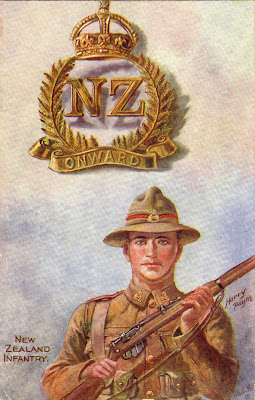No. 3160
"New Zealand. By many brave and heroic deeds has the motto of the New Zealand fighting man, "Onward" been upheld by these smart and soldierly troops. Proudly will they be able to tell their sons and grandsons how they helped the Mother Country in her hour of need in the Great War. Their hats are distinguished by the bands, red for Infantry and green for Light Cavalry. The cap badge formerly was one plain fern leaf, but the one here shown is now universally used."
Set: Colonial Badges and their Wearers.
No. 3160
"Australia. The whole world now knows of the important and brilliant achievements of the Australians in this the greatest and fiercest war in history, how they have time and again gone in the thickest of the fight to win a certain position and to keep it when gained. The black badge is universal with all Australian troops and is worn on the flap of the hat. The regimental badges are worn on the collar."

Set: Colonial Badges and their Wearers.
No. 3160
"Newfoundland. Although Newfoundland may not be a very thickly populated country, she has been able to send a find body of sturdy troops to help the Mother Country in her hour of need, and the sons she sent have done bravely and well in many a hard fought action. Their badge is a striking design of and Elk or Reindeer and is worn on the service cap and the collar."
Set: Colonial Badges and their Wearers.
No. 3160
"Canada. Until a few years ago the various regiments of Canada possessed their own distinctive titles, such, for instance, as the "Winnipeg Rifles", the "Three Rivers Infantry", etc, but they are now known only by the number of the battalion. The universal badge of the maple leaf is worn, with very few exceptions, on the cap and the battalion badge on the collar. The homage and gratitude of the whole Empire goes out to the Canadians for the heroic part they have played in the Great War."
Pictured are four postcards from a set of six painted by the popular British artist Harry Payne (1858 - 1927) and entitled Colonial Badges and their Wearers. Harry worked with the large postcard publishing house of Raphael Tuck and Sons from 1884 right through until the end of the First World War. This Oilette set which includes two other postcards not pictured, Canadian Cavalry and South African Infantry, was one of many sets Harry Payne produced for Raphael Tuck. He also produced postcards for publisher Gale and Polden. His older brother Arthur Charles Payne was also an accomplished artist and sometimes worked with his brother to produce fine pieces of work. Harry was a prolific artist of portrait and landscape painting while his brother Arthur specialised in architectural subjects. Their collaboration often meant that Arthur would paint the background and Harry the figure portraits.
Harry Payne painted many other postcards of soldiers during the First World War and all of these portrayed their uniformed subjects in excellent detail. It is for this reason that Harry Payne's postcards are keenly sought by collectors today.



No comments:
Post a Comment